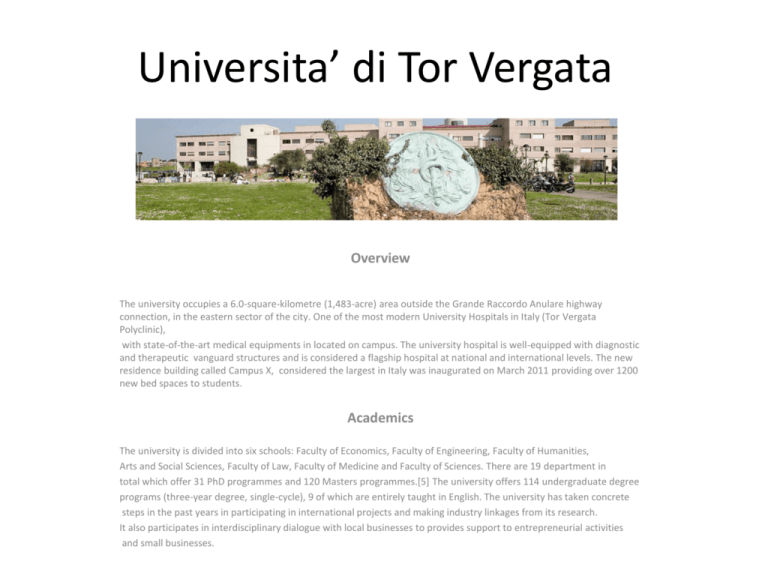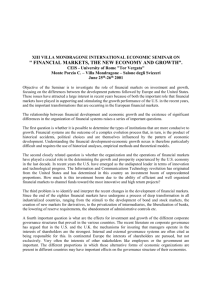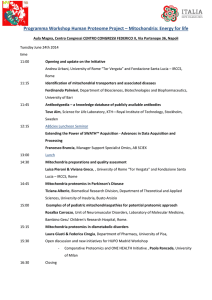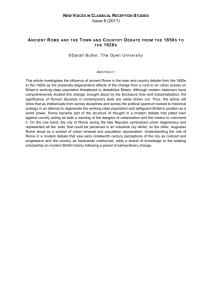Universita* di Tor Vergata
advertisement

Universita’ di Tor Vergata Overview The university occupies a 6.0-square-kilometre (1,483-acre) area outside the Grande Raccordo Anulare highway connection, in the eastern sector of the city. One of the most modern University Hospitals in Italy (Tor Vergata Polyclinic), with state-of-the-art medical equipments in located on campus. The university hospital is well-equipped with diagnostic and therapeutic vanguard structures and is considered a flagship hospital at national and international levels. The new residence building called Campus X, considered the largest in Italy was inaugurated on March 2011 providing over 1200 new bed spaces to students. Academics The university is divided into six schools: Faculty of Economics, Faculty of Engineering, Faculty of Humanities, Arts and Social Sciences, Faculty of Law, Faculty of Medicine and Faculty of Sciences. There are 19 department in total which offer 31 PhD programmes and 120 Masters programmes.[5] The university offers 114 undergraduate degree programs (three-year degree, single-cycle), 9 of which are entirely taught in English. The university has taken concrete steps in the past years in participating in international projects and making industry linkages from its research. It also participates in interdisciplinary dialogue with local businesses to provides support to entrepreneurial activities and small businesses. Research Research is carried out in 27 departmental and inter-departmental research centers. On campus there are also other major research institutions. The new main headquarters of the Italian Space Agency was inaugurated in Tor Vergata on July 25, 2012.[11] Other important national centres include the Tor Vergata research establishment of National Research Council and the National Institute for Astrophysics. The close proximity and research ties with other distinguished research centers that are near campus, such as the Italian National Agency for New Technologies, Energy and Environment(ENEA), the European Space Agency Center for Earth Observation and the Italian National Institute of Nuclear Physics makes Tor Vergata a unique research environment and one of the most dynamic aggregations in the country. Facts and Figures • • • • • • • • • • • • • • • • • • • • • 43.000 Students 1.538 Faculty Members 962 Technicians and Administrative Staff 600 Hectares is the University Campus area 6 Schools (Economics, Law, Engineering, Arts and Humanities, Medicine, Science) 113 Ist level degrees, II level degrees and single-cycle degree courses* 157 Post Graduate and Master Courses* 54 Specializing Schools 492 Laboratories 357 didactic rooms hosting a total of 28,419 students 30 On-line enrollment standing locations throughout the campus 28 Departments 78 Ph.D. Programs 330 Research Fellowships issued every year 30 University Centers (Interdisciplinary, Research, Language Teaching, etc.) 6 Area Libraries (Bio-Medical, Law, etc.) 676 Ph.D. scholarships issued 1.000 Stages are activated every year 516 Remunerated short-term Collaborations for Top Students 554 Erasmus scholarships issued every year 100 Leonardo Scholarships Policlinico di Tor Vergata The creation of the Policlinico di Tor Vergata has roots in coomon with a desire to build a new model of Hospital, characterized by a smaller number of rooms, a high technological value and extremely qualified personnel, able to deliver a complete medical service that includes: High-care, an high level of intensive care that results in shot periods of degency A complete day-hospital service A complete rehab service, in conjunction with the family medic. Such project has been developed from 2000 and finished in 2005. These are the number of patients for 2011: Laboratory Medicine: 1.392.736 Imaging Diagnosis: 135.851 Ambulatory: 355.048 Ordinary Hospitalizations: 14.134 Day-Care Hospitalizations: 12.778 Emergency Room: 55.026 Total number of employees: 1803 Direttore Generale Prof. Enrico BOLLERO Campus X CampusX is a green oasis in the suburb of Tor Vergata. CampusX allows its guests to get to their own faculty in just a few minutes on foot, saving time and money. It's also conveniently located next to the Fiumicino and Ciampino airports, as well as being just a few blocks away from the Tor Vergata hospital, which makes it an ideal place for Medicine and Chirurgy students. CampusX has over 700 accomodations in single or double rooms, as well as a great variety of services and utilities such as study and tutor rooms, food court, coffee bar, bus shuttle, photocopy store, auditorium, gym, spa, market, music hall, leisure rooms and wi-fi. THE HISTORY OF ROME- THE ETERNAL CITY Several expressions have been used to describe the unique city of Rome and capital of Italy. The ‘navel' of the world, the eternal city, centre of western Christianity to cite just a few. The History of Rome boasts over three thousand years of history that have created the character of the city and left their mark in forming an urban structure with no comparison. Every century gentlemen of Rome from generals to emperors, from popes to princes, have left their personal stamp on the city. They were responsible for commissioning artists and architects to design the most famous buildings, sculptures and paintings which today give the city it's enchanting appearance. The capital combines both past and present, as well as secular and Christian. During the course of the long history of Rome, the city has decisively influenced the religious and cultural direction of Europe. Latin, the language of the Antique Empire, makes up the foundations of many of western Europe's languages. Antique Rome's political and judiciary systems have been used as a model for a large number of states and legislative systems. During medieval times the concept of the Imperial Christian emerges from Rome, while the Pope's power strengthened during the renaissance era and their court became the cultural centre acting as a catalyst the history of Rome moved in to another direction. For many a century the fame and fortune of Rome was interwined with the Church and when the Pope left Rome for France the city suffered terrible economic consequences. But, in modern history, Rome has regained importance especially since the re-unification of Italy symbolized by the imposing memorial to Vittorio Emanuele II is considered to be the heart of Rome at Piazza Venezia. Architecture, sculptures and paintings of ancient Rome have served as a model for all western art both in antiquity and modern day. The city of Rome still attracts and amazes millions of visitors with its never-ending story. The history of Rome that spans millennia is still there to be discovered, and with a local expert guide you can re-live the great days of the Eternal City. It's easy to travel around the city thanks to ATAC, the public company that offers a complete bus service any time of day. Moreover, trains and metro system allow to get anywhere while avoiding car traffic. The metro stop "Agnagnina" is ideal to get to the Tor Vergata University. Rome is a city full of attractions and activities. Discovering all the monuments that ancient Emperors left us would be a very long task. The weather in Rome is typically mediterranenan, which means winters are not excessively cold. As a result of that, citizens of Rome often like to indulge in a trip to the "colli romani" (small hills around the cuty) or to Ostia, a famous seaside resort few kilometers away from Rome. A 5 minute walk in any direction will take you to a restaurant with traditional Italian food, and along the river Tevere during the late afternoon and night it's possibile to experience the "Lungotevere", an endless stream of restaurant and pubs with local food and drinks where people relax after work or after a long day of studying. Rome facts and figures Population of Rome: 2.8 million inhabitants Area: 1,285 km2 (580 sq mi) Country: Italy, Region: Lazio Time: GMT/UTC + 1 hour (+ 2 hours in summer) Telephone area code: +39(06) Currency: The euro: 100 cents = 1 euro Emergency numbers: Dial 112 anywhere in the EU to reach the emergency services. Local numbers: Police 112, Ambulance 113, Fire 115 Rome climate: Temperate; mild, rainy winters (September to mid-May) with hot, dry summers (May to September) What to eat and drink when in Rome When in Rome, there is one thing you won’t have to worry about: being able to find a nice place to eat. From family run trattorias and pizzerias, to fancier, hip restaurants, Rome knows how to quench your hunger and satisfy her visitors with her savoury specialties. Roman food is a popular, yet simple one. It is not sophisticated or elaborate, but generous, rich in flavours and character, and full of many mouth-watering recipes. The typical Roman food has its roots in the past and reflects the old traditions in most of its offerings. It is based on fresh vegetables (the king is definitely the artichoke, whether deep fried, simmered in olive oil with garlic and mint, or “alla giudia”), not expensive cuts of meats (the so called “quinto quarto,” meaning mainly innards, cooked with herbs and hot chilli pepper). It also consists of deep fried, tasty appetizers (such as salted cod and filled zucchini blossoms) and sharp “pecorino cheese" (made from sheep’s milk from the nearby countryside), a very important ingredient in many recipes. Not to mention the pasta, of course, a staple for every Italian, and therefore every Roman. From “carbonara” to spaghetti “ajo e ojo” (simple but so effective, with its fiery mix of olive oil, garlic and chili pepper), from rigatoni “con pajata” to a hearty, fragrant soup such as “pasta e ceci.” There are few Roman desserts, and they are mainly connected to festivities (Carnival, Eastern or Christmas). They are definitely worth a try, however, especially the ricotta cake, which is made with fresh ricotta cheese mixed with sugar, lemon, vanilla, candied fruits, pine nuts and raisins. Getting to and around Tor Vergata Central Administration Via O. Raimondo, 18 00173 Rome School of Medicine and Surgery Via Montpellier, 1 00133 Rome Underground/Subway from TERMINI Railway Station take the orange line (A) to ANAGNINA get off at Anagnina and take one of the following: 20 express -from Anagnina to Via Cambridge 500 - from Anagnina to Policlinico Surface rail : Roma-Pantano (Casilino)- get offat Torrenova Autobus and get on bus number 105 or 507 Buses number 105 - 157on Via Casilina will also connect you to the campus Suburban *ATRAL bus line: Ciampino Railway Station – Tor Vergata Administration Bldg. Suburban COTRAL bus line: The service links Marino, Grottaferrata, Frascati, Tor Vergata Railway station, the university Campus and the subway/underground station Anagnina.







